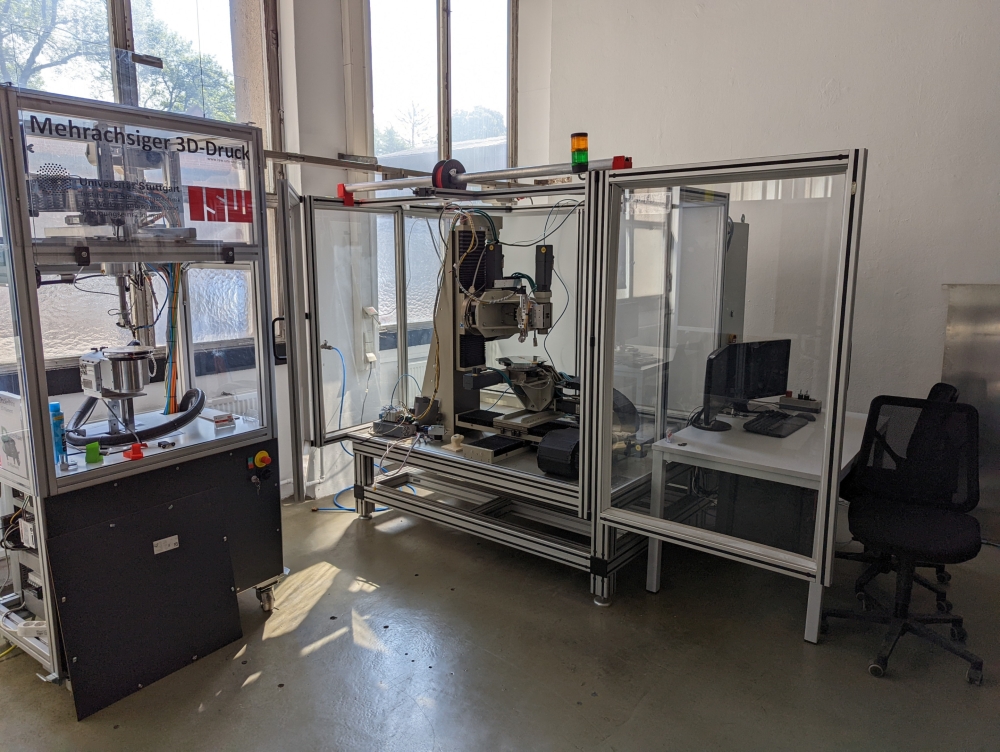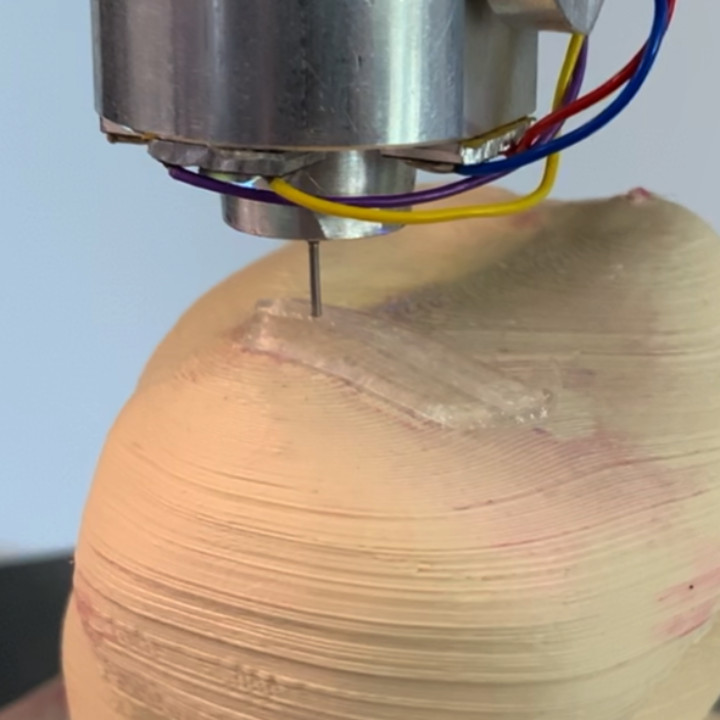Help with osteoarthritis of the knee
Individualised knee-joint cartilage: artificial tissue that fits
Our knee joints are subject to considerable stress throughout our lives. Although nature has provided them with a shock absorber in the form of cartilage, this wears away over a lifetime, leading many people to develop osteoarthritis of the knee. Treatment is available, for example in the form of artificial cartilage. However, this "off-the-shelf" tissue often does not grow well into a patient’s bone. Researchers at the University of Stuttgart are now developing an individualised cartilage replacement made from biomaterial that is produced individually by 3D printing on the basis of MR images.
Used billions of times during our lives, our joints are one of the body’s weak points. In the knee joint, for example, the femur and tibia are movably connected. The bones do not rub directly against each other because the joint surfaces are coated with cartilage that protects against bone wear - at least initially. This is because this cartilage deforms when force is applied and has to withstand considerable forces with every movement. No wonder, then, that the tissue becomes increasingly damaged and degenerates over the course of our lives.
However, if this shock absorber is missing, or if it has become rough and worn, bone rubs directly against bone with no protection. This results in osteoarthritis of the knee, which may be asymptomatic, but for millions of people is associated with considerable pain, restricted movement, and even joint stiffening.
Greater chance of healing when the geometry matches
 At the University of Stuttgart’s Institute for Control Engineering of Machine Tools and Manufacturing Units, artificial joint cartilage is printed three-dimensionally using a novel multi-axis process. © ISW
At the University of Stuttgart’s Institute for Control Engineering of Machine Tools and Manufacturing Units, artificial joint cartilage is printed three-dimensionally using a novel multi-axis process. © ISWTreatment is available for osteoarthrosis of the knee, but if pain-relieving medication or physiotherapy do not help in the long run, the only options are an artificial knee or artificial cartilage tissue, depending on the size of the area affected by wear and tear. Although these implants are very sophisticated, they are usually made for the average patient. This means that if the individual geometry of the knee joint to be operated on is similar to the average, the operation has a high probability of success. If this is not the case, problems can arise, such as the artificial tissue not growing well into the joint.
This is why researchers from the Stuttgart Partnership Initiative - Mass Personalisation (SPI-MP) research network have been working to produce artificial personalised cartilage tissue from biomaterials that can be individually adapted to a patient's geometry. This dramatically improves the chances of healing. Proof of concept has now been provided: "The first step towards innovation has been taken," reports Prof. Dr. Günter Tovar, spokesperson for the SPI-MP. "We have produced biological bone-cartilage implants for knee joints using 3D printing from fragments of collagen and other endogenous substances."
Multi-axis 3D printing of hydrogels for the first time
The new procedure is based on MR images of the knee joint for which the personalised cartilage replacement is intended. These images and their scan data are first used to calculate a target geometry of the defect to be replaced, and this is then taken as the basis for determining the sequence of the individual printing process. The 3D printing process used to create these geometrically complex biological objects is the first to apply a multi-axis process. A specific biomaterial printing process was established at the University of Stuttgart’s Institute for Control Engineering of Machine Tools and Manufacturing Units (ISW). The entire procedure can be automated as a fully digital process.
The 3D printing process uses up to seven axes, compared to previous three-axis techniques, to reproduce the conditions in the joint much more realistically. "With the multi-axis process, the substrate can still be rotated around its own axis during printing, for example," explains Tovar. "This is completely new as far as flexible materials are concerned. It was already possible to process solid materials such as metals very effectively, but our bodies consist of a very large proportion of fluid stored in polymer networks, hydrogels, as we call them, and such tissue is anything but solid. The same applies to cartilage. Articular cartilage also has to be very resilient. There are crazy forces at work here, and this is a particular challenge. Nature has created complex molecular structures for this purpose. We are now trying to approach these biomimetically and process hydrogels in three dimensions."
New cartilage tissue replacement comes very close to natural tissue
 Researchers at the SPI-MP have developed a 3D printing technique to produce individualised artificial knee joint cartilage in a way that mimics nature. © ISW
Researchers at the SPI-MP have developed a 3D printing technique to produce individualised artificial knee joint cartilage in a way that mimics nature. © ISWResearch work on the material for cartilage replacement is being carried out at the University of Stuttgart’s Institute for Interfacial Process Engineering and Plasma Technology (IGVP), where Tovar is deputy director. The aim was to make the artificial cartilage as lifelike as possible, as well as stable and easy to process in the printer. The researchers chose a bottom-up approach, approaching the optimal material from the macromolecular level and then testing it in 3D printing. The result is a hydrogel ink made from a methacryl-modified gelatine solution that is hardened to be UV-resistant. In principle, it would also be possible to coat the material with living cells from the bioreactor before implantation.
"Gelatine consists mainly of collagen fragments, just like real cartilage. We mix these with other substances from the body in such a way that a printable hydrogel is created, which is then specifically hardened with the help of light," says the professor. "This structure is already very close to nature. Nevertheless, we are still working on optimising the material and its processing. We want to push this innovation as far as possible, but we won't be able to follow it through to implementation. This requires other experts and they will accompany us up to market launch. However, obtaining marketing authorisation is extremely difficult and unfortunately takes a long time. We have therefore decided against a solution involving living cells, which would make things more complicated still. In the EU, regulations tend to stifle innovation.”
Experts from the Stuttgart Sports Clinic are advising the research network. The cartilage project is also part of the large-scale, 5.9-million-euro EU project TRiAnkle, in which twelve partners from research, industry and hospitals are developing regenerative, personalised and 3D-printable implants for joints, ligaments and tendons - initially for the foot. In future, the innovation is expected to reduce recovery time from injury by half and improve functionality by up to 15 percent. In addition to the IGVP, FC Barcelona’s Innovation Hub and the associated sports clinic are also involved. Once the innovative therapy concept becomes available in practice, it is expected to benefit many millions of people worldwide, as well as sports clubs, where injured athletes will be able to return to competition more quickly.
The SPI-MP research network
SPI-MP stands for "Stuttgart Partnership Initiative - Mass Personalisation" and is part of the High-Performance Centre Mass Personalisation (LZMP). The LZMP is a joint initiative of the University of Stuttgart and the Fraunhofer Institutes in Stuttgart.
Excellent basic research into manufacturing technologies and biomaterial technologies for personalised biomedical systems is being conducted at the SPI-MP in seven projects. The network is financially supported by the Baden-Württemberg Ministry of Science, Research and the Arts.
The Institute for Control Engineering of Machine Tools and Manufacturing Units (ISW) and the Institute of Interfacial Process Engineering and Plasma Technology (IGVP) are involved in the "Personalised Cartilage Implants" project.